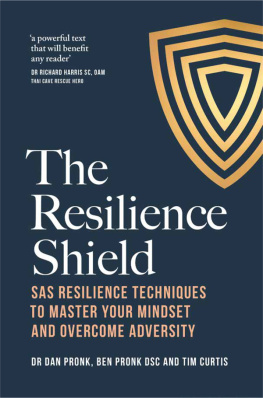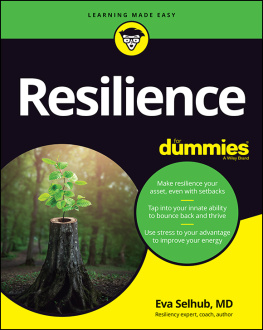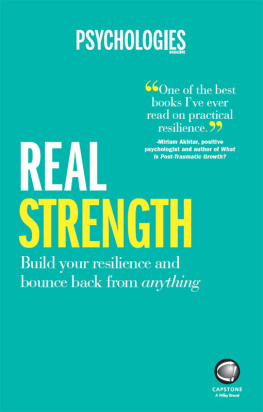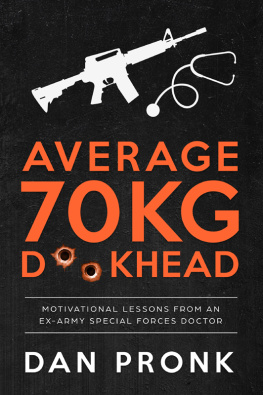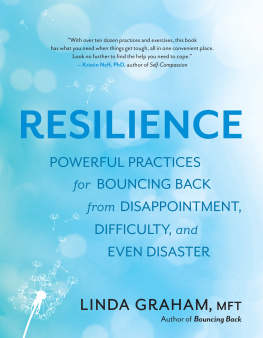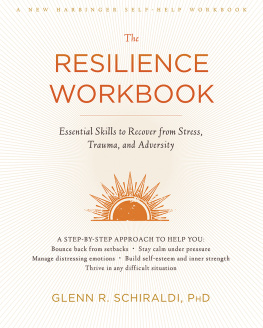About The Resilience Shield
a powerful text that will benefit any reader Dr Richard Harris SC, OAM, hero of the Thai cave rescue
Life is hard. Rocketing rates of physical and mental health issues are testimony to the immense pressures of our complex world. So how do we become tough and adaptable to face lifes challenges?
The Resilience Shield provides that defence. In their groundbreaking guide to overcoming adversity, Australian SAS veterans Dr Dan Pronk, Ben Pronk DSC and Tim Curtis take you behind the scenes of special operations missions, into the boardrooms of leading companies and through the depths of contemporary research in order to demystify and define resilience. Through lessons learned in and out of uniform, theyve come to understand the critical components of resilience and how it can be developed in anyone including you.
The Resilience Shield explores the hard-won resilience secrets of elite soldiers and the latest thinking on mental and physical wellbeing. This book will equip you with an arsenal of practical tools for you to start making immediate improvements in your life that are attainable and sustainable.
Lets build your shield!

To Henk Pronk and Rod Curtis
Contents
Prologue
BEN URUZGAN PROVINCE, AFGHANISTAN, 2008
There was no real noise, just a sudden, forceful intake of breath and the vehicle in front of us disappeared, smoke and dust and slow-motion debris raining. It was just like in the movies: the soundtrack cut out abruptly, clattering vehicle noise and radio chatter replaced in an instant by a tinnitus monotone. A wheel, tyre still inflated, bounced again in slow motion out of the cloud, and still no sound but for the urgently whispered (shouted?) Fuck! from inside my vehicle. Was it hours that passed before anything further happened? The reptilian automaton deep in my brainstem was already calling the incident in, requesting recovery, warning out medevac, but this was all reflex my conscious self sat dumbly watching the dust bloom and bloom, the tan edge of its talc balloon now reaching the windscreen of my truck, gently enveloping us too.
Without realising Id moved, I was outside our vehicle, stupidly moving forward, off the road, and the soundtrack suddenly caught up. The first noise I heard was the screaming that still lurks on the fringes of my foremind, occasionally making sudden and unexpected forays into my thought.
I was close before I could actually see. The vehicle was completely eviscerated, its entrails strewn in a blossom pattern radiating geometrically from the blast seat. Carnage, both human and machine. Panning across this scene, my eyes were drawn to the fork of a nearby tree in which a Snickers bar and some underpants were wedged like some strange local fruit, and then to bins full of 40 mm grenades strewn carelessly on the ground like Easter eggs under the roadside trees.
The man who had been sitting at the rear of the car, facing backwards, had now propped himself up 6 metres away where hed landed, silently and fastidiously applying a bandage to a small cut on his shin while torrents of blood poured unnoticed from his neck onto the front of his armour. And still the noise, the godless screaming the top gunner its source, staring in disbelief at the pulp where his right thigh had been moments earlier. Our medic, quick to his side, working rapidly, asking him to rate the pain and him screaming, Ten, ten, ten, over and over and over like a broken mantra, and even the ampoules and ampoules of morphine couldnt silence him.
All around the boys reacted as theyd been drilled, security posts out quickly, arcs of fire silently interlocked, daring a follow-up attack. The medics fetched sloppy bags of saline and established lines in constricted veins, reassuring their scared and broken friends. The driver of the mangled vehicle, somehow unhurt, wandered sobbing up and down the road, fixated on the minutiae of the carnage, paralysed by the guilt of the unscathed, until someone grabbed him by the shoulder and steered him away, making crude jokes about his driving and pretending his rifle was needed on the perimeter taking his focus off the blast, handing him back some semblance of control and self-worth. And me, I contributed, although how I, how any of us, functioned in that time-stood-still Hades is lost to me now. What I do still possess, however, is the laminated medevac card graffitied with my childs-scrawl description of the carnage Pri 1, multiple upper leg fractures, likely internal bleeding, facial lacerations, blood pressure falling studious dictations from the medics, none of which I recall writing, but which I must have relayed to get the helicopters there as fast as they came.

This book exists because of the authors lived experiences. It is born of situations like the convoy ambush described above, of our own personal traumas and of observations of friends who have walked through hell and emerged on the other side some without a mental scratch, some better for the experience, others destroyed. It has been written in the echoes of black-humour-induced laughter and the sobs of children, heard both in dusty Afghan qalas and at funeral services in Perth. And along the way, it has been informed by long days of academic study and medical practice, the failures of self-medication and the successes of simply observing ones own breath; by the rock provided by loved ones and by the North Star of ancient philosophies. By deadlifting, by meditating and by reflecting deeply on the musings of long-dead poets and the reflexive wisdom of children. It is the culmination of years of trial and error, of failure and feedback. Of learning from people far wiser than us and assisting countless business clients to develop their individual and collective defences against an unrelenting, confusing and unforgiving world.
This book is written for you. While its genesis can be traced to the far-flung battlefields of Iraq, Sierra Leone and Afghanistan, our ongoing research and practical application of the concepts presented herein continue to demonstrate that the resilience requirements of elite soldiers, solicitors and students differ by degree, not kind. Our techniques are specifically designed to be understandable, achievable and sustainable, and we have collated them in this book so they are accessible to anyone who wants to understand more about the concept of resilience and discover practical methods of developing it.
We hope you enjoy it.
We hope it prompts you to look at aspects of your existence in a different way.
We hope it changes your life.
1
Build Your Shield
DAN ADELAIDE, SOUTH AUSTRALIA, 2014
I had seen the cliff coming for six months before I eventually fell off it. I thought that I had prepared myself well for the fall. I was wrong. Having spent the preceding 14 years in the army, and the last five with special operations, I was looking forward to a slower-paced and simpler life with my young family.
As a doctor, my post-army job prospects were good and promised wages significantly higher than I had been earning during my military service. We would be moving back to a newly built house in my wifes hometown, which meant more social support for the family. I had accumulated a significant amount of leave, which would allow me to ease into civilian life without the pressure of needing to find work immediately. As a precaution to stave off boredom and to have a structured focus in my life following my immediate discharge, I had enrolled in a Master of Business Administration. I was physically relatively uninjured from my service, and while I had experienced a significant degree of psychological trauma during my four tours of Afghanistan with special operations, at that point I was seemingly unaffected by it. I had navely anticipated that the void that would be created in my life by leaving the army could be neatly filled with increased family time, post-graduate study, a new job and increased income.

